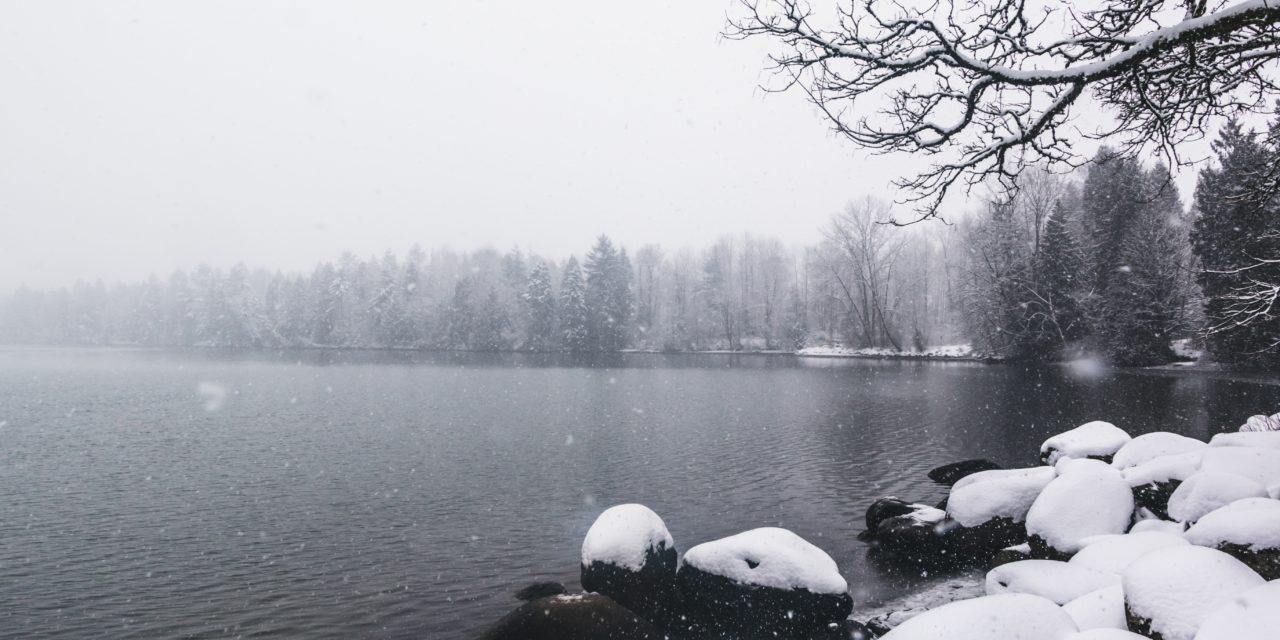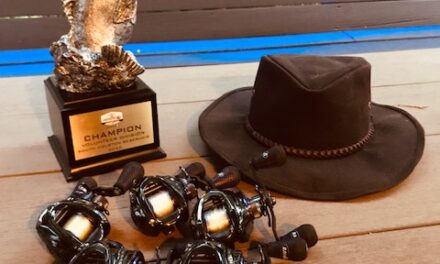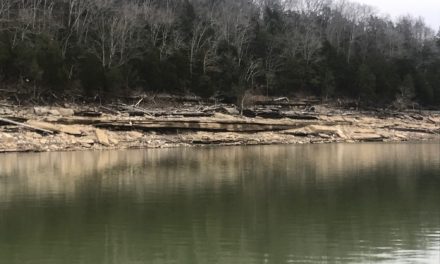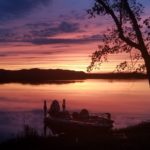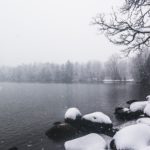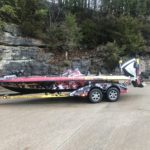‘If you want to fish professionally, move to Lake Cumberland.’ I say this to aspiring anglers all the time. I myself chose Cumberland as my home lake because of the complexity involved in achieving success on any given trip. I am fortunate to travel to a lot of fisheries, and most are predictable to a significant degree, but if you want to learn how to succeed when the smallest evaluation is the difference between catching fish and returning home empty handed, Cumberland is the lake for you. There is a simple reason for this, bass in general, on any body of water, don’t want to get caught. On Cumberland, the fish are such a mean spirited bunch that ruining your day, particularly if you are on vacation has become a pastime.
For those of you that have never been to Cumberland, here’s a few details. The fishery is a highland reservoir, utterly huge, both a lake and a river, excessively deep, generally featureless, varies 60 feet in terms of depth, lacks any vegetation, is packed with a vicious lot of Stripers, subject to four full seasons but somehow not in any particular order, is too hot in the summer, too cold in the winter, and is full of bass who conform only to their own patterns, somehow ignoring the direction of professional bass anglers on where to be and when.
All bass fishing terminology aside. The reason I believe Cumberland is so essential to the training of an angler is that to be successful on this lake, it is necessary to understand that this is a roaming environment. A roaming model roughly translates to the concept that on a body of water with 1200+ miles of shoreline, the bass can technically be anywhere. But the kicker is that they might not be on the shore at all, they might be floating about in the middle of the 65,000 acres of open water, on the bottom as deep as 50 feet, lounging on the dock, on vacation in the Harris Chain…who knows. Pretty much anywhere, with only their own ideas and a plethora of shad to inform their whereabouts. If you take traditional thinking to Cumberland, its going to be a long ride back to the dock. The day ends in many cases with they were ‘supposed to be’ there. The problem is that ‘supposed to be’ rarely ‘is.’
Now you may have clicked on this article because you are interested in where to go when you are fishing Cumberland. That is what this post is about, but not in the traditional sense. I have heard all kinds of great stuff when people discuss this lake. For example, the western side of the lake is better than the eastern side.
Not true.
The western side fishes like a lake whereas the eastern side is a river. The majority of fisherman are lake oriented and this is how such falsehoods arise. Fish accordingly and they are generally equivalent. Personally I believe the central portion of the lake is better than both and that is also untrue. But in any case, everyone has a different idea of where to go, when, and why. Perhaps that is what makes tournament fishing so interesting.
Cumberland is not about spots. It is about patterns, and anti-patterns. Now this is difficult to put into words exactly, because I would term it as more of an instinct, or a sense of what to do in particular situations. But when I consider myself as a fisherman before living at Cumberland and after, I see very little in terms of connection. This place has utterly changed the way I see bass fishing, and has directly altered my reasoning on how to locate, and pursue unruly bass.
Years ago when I was just getting started, like many anglers before me, I made the shift from ‘Spot’ fishing to ‘Pattern’ fishing. And there are many excellent discussions on this topic so there is no need to go into it here. At that time, I believed that becoming a ‘pattern’ fisherman was the holy grail and that once I had made that shift, I would be competitive on any lake. To some degree, that is actually not an incorrect statement. However, as I began to enjoy some significant success, I still felt that there was something missing in my approach. I believe that many of you likely feel that as well.
What was missing for me was the freedom to embrace the anti-pattern.
What is the Anti-Pattern?
When I began at Cumberland, applying the pattern oriented techniques served to keep me catching fish, but I struggled in numbers and the sort of fish I was looking to take. Over time, I realized that, like many anglers, I was laying a pattern perspective over the lake, and searching for features that corresponded to the behavioral expectations of the bass.
Now there is no question pattern fishing is complex and takes a long time to really understand. And yet while it has great value, Cumberland taught me that patterns should be viewed more as starting points, not canon. This was my fundamental problem, I saw the pattern approach as the end all in strategic planning. But the pattern approach falls short because it is based on an exclusionary concept.
To be specific, breaking down water is where, for me, the problem begins. Whenever you hear about fisherman breaking down water, especially on a large lake, the first thing they discuss is water exclusion. In order to simplify the fishing, water is excluded based on empirical information regarding how fish act under certain conditions. Its this exclusionary practice that I began to question, and as I developed this model I began to call it the Anti-pattern approach. Ironically, the most common name from my experience is actually junk fishing.
The first tenet of Anti-Pattern fishing is that there is no exclusion. The traditional pattern is simply a starting point, with the counterpoints represented in opposition. Thus, if the pattern suggests that fish are holding deep on the rocks against secondary points, the anti-pattern would be suspended in deep water off main points. If the pattern suggests shallows at the back of creeks, the anti-pattern would be the bottom of the deeper portion of the creek bed. There can be any combination of pattern and anti-pattern. All water is in play. So there are a number of immediate considerations that must be accepted.
- Time is now more important than it ever was. Because the lake will no longer be broken down, there is vastly more area to cover.
- Creativity now becomes the most essential skill, both this and the willingness to explore ideas, and take risks.
- You must develop a sense of when to move on.
I struggled here for at least 6 months when I began to put together this concept. How long is long enough to determine an area is not producing. Is it 20 minutes? An hour, the morning? What about changes during the day, does a particular area repeat in the process? The answers here are difficult because what we have introduced is the problem of permutations. This issue bothers me to a great degree. There are so many times when I am fishing where I consider the vastness of the water and get this feeling of what I can only describe as hopelessness, because most of any body of water is actually desolate. This is doubly so in a highland reservoir. That hopelessness comes from the realization that one could fish all day and never pull a lure past an actual bass.
This is where time becomes so critical. I have developed a concept that I believe might be a bit extreme, but for now it has served me well and I continue to explore it. When you are catching fish, did you ever notice the fisherman/fish interaction, and how often it occurs. Even when you actually catching a fish, there are short strikes, the irritating nibbles, tale slaps, etc. Boiled down, it amounts to an indicator that the fish are participating in the process.
If I am fishing a spot for longer than 3 minutes with no indicator that fish are participating in the process, I move on. There are a number of reasons for this rapid determination of whether a pattern and location are viable.
- The assumption exists that fish are always biting. There is no concept of slowness that warrants drilling an area repetitively.
- I have no interest in the proverbial fish per hour or hours. Thus I am looking for a highly active environment.
- I don’t just want to find a productive solution, I want to find the most productive solution.
The Anti-pattern is a way of thinking about fishing strategy that accepts the absolute uncertainty in the process of locating and capturing quality bass, but at the same time mandates that the fisherman accept nothing less than a highly target rich environment. Strangely enough, many big bass fisherman often talk about the Anti-pattern approach without using this term. It is essentially freedom from the diatribe of thinking that is hammered into fishermen in magazines, books, fishing shops, and friendly conversations. Why? Because the traditional approach has been shown to be empirically incorrect. If the traditional pattern oriented thinking was correct, then everyone would catch fish on a prolific level. But they do not, even at the professional level. Something is missing. And that missing link is compensated for the idea that power fishing, covering water in a limited number of related patterns, can achieve success via repetition. This is something that really bothered me early in the process. Power fishing simply feels like work. If I cast more, cover more water, work harder, I will catch more fish. And it’s true, you will. But this is a brute force approach that I have never come to really accept.
Because doing so is an acceptance that fishing a lower catch rate pattern and/or water is acceptable. In my mind, you cannot improve in this model. You can catch fish, you can even win. But something feels wrong to me in this approach.
Consider if we break down the statistics. Lets say 1 out of 200 casts result in a keeper bass. Is the answer to get to a limit 1000 casts? For many in power fishing, that is exactly the answer. What if water is out there that exhibits 1 out of 20 casts resulting in a keeper. Now it takes 100 casts for a limit. If you expend 800 tester casts finding this pattern/location, you are net positive vs. traditional power fishing.
This is the concept of the Anti-pattern in pure scientific terms, but for me its more than that, its about elegance in the pursuit of bass, in my understanding of the water, in my approach to the sport.
Thus, this model suggests that on any given day, with any given conditions, fish might be located anywhere, hit anything, and no longer are subject to stereotypical analysis. It essentially suggests that the cycle of fishing, each day and on an intraday basis, is assess, apply, reassess, reapply in a highly rapid progression. There are a couple of things that quickly became apparent.
- Planning is generally unimportant.
- While understanding the water, and its features is essential, practice is also unimportant.
- If you are not actively catching fish, you are applying the wrong pattern and should shift strategies immediately.
On day one, I was sitting at the dock at 5 am, fully convinced the Anti-pattern ideology was correct, and no idea how to proceed. What came after changed the way I approached fishing, both in terms of preparation, technique, equipment, everything.
It began with how to approach the water.
In the past, I would begin with a pattern, and pour over maps looking for areas that matched the pattern. Long shelves, shallow flats, primary points, secondary point, current formations, creek beds, sunken houseboats, submerged railroads, the list is endless. This all changed because what I began looking for were areas that compressed many different types of water ‘featurettes’ in a relatively small area. So I wanted shallows, points, deep channels, suspension zones, structure, outlying rocks, all within say a mile of one another, although smaller was optimal. Next, I wanted this zone as close to the departing dock as possible. This is so important.
I want to be fishing within 5 minutes of leaving the dock on every trip.
These zones would be used for rapid pattern identification. The ‘featurettes’ themselves would be mapped to large structures on the lake that offered wide reaching variation within the particular style. At the outset of a trip I would quickly reach the identification area, and rapidly fish each ‘feature’ in progression. And what amazed me was that as I grew used to the methodology, the time taken for each area shortened significantly. I found myself throwing jigs, swim jigs, crank baits, spinners, drop shots, spoons, and top water, each with subvariation, all in the first 20 minutes of fishing. I don’t honestly believe I get past 5-8 casts on a particular feature before I mentally label it as something to pursue or disregard.
Even as I write this, it seems so obvious, like maybe I was the only one who didn’t get it, maybe this whole thing is what everyone else already knows and I am just waking up to it, but I don’t think so. What I remember most was my tenacity and dedication to thoroughly cover water inside of the pattern-based suppositions I had developed. This approach ate up time, and if I was correct, it was fantastic, but if I was wrong, the failure to adjust crippled my ability to succeed. What I recall most was my inability to pivot. I created a plan and followed it to the letter, come what may. And this was my undoing on the water.
The model I shifted to was just about diametrically opposite to my initial approach, adjustment and the continual search for a better, producing pattern is the essence of the Anti-pattern approach.
Strangely, I formed the concept on Lake Cumberland, but it all came together on Lake Champlain, which even now surprises me in terms of what happened on that sunny day in Vermont late last summer.
The Anti-Pattern in Action – Lake Champlain
It was all supposed to be automatic. Up at 6 am, quick breakfast, put in the boat, run to the inland sea, drop shot in 20 feet of water off one of the many main points, haul them in all day. Now I was particularly emboldened on this morning because I had just come from the 1000 Islands where the pattern was/is similar and the St. Lawrence river was relatively identical to what every book and video suggests. Its interesting because there was a sub-pattern, or an optimization, I will go into in another article that yielded considerably bigger fish but I will generalize by saying I did not have to look hard to catch fish, and I was riding a wave of nearly 2 weeks of excellent fishing.
Until the first three hours of Lake Champlain where I got crushed. Nothing, not a single bite. There I was floating along with about 5 other boats, going through the same useless motions on the same desolate water. All of us dutifully following the pattern and coming up shorthanded.
So here I was around 10 am on a sunny day, few clouds, no wind, clear water, Lake Champlain, Vermont USA. And this is when I began to seriously conceptualize what the Anti-pattern would suggest. The answer was immediately obvious. Drop shot in 20 feet of water vs. throwing a spinner in 5-8 feet of water. On a calm day, this is literally the opposite and for the record, did not have a chance to catch a fish.
Until I caught a 4 lb. largemouth on my second cast. Followed by a second 4 pounder within a minute of the first. This was the beginning of a 22 pound day, all caught on white spinnerbaits in less than 10 feet of clear, motionless, water.
It should never have happened. It was all wrong, spinners don’t work in clear calm water. Bass aren’t in the shallows during that portion of the year. And no one fishes the Anti-pattern.
Except on that particular day, the Anti-pattern was the pattern. Which dispels the concept altogether and takes us back to square one. Drop all pretenses of what the fish should be doing and where they should be. Use it as a starting point of course. But once that starting point is shown to be unproductive, move on rapidly.
This is a concept that is still developing for me conceptually, and will continue to do so over time. I consider the Anti-pattern to be the defining aspect of what I am terming as a year of development. If there is anything you take from this article, it’s fish with an open mind. Explore ideas without preconception, and fish with a rapid and adaptive style.
I would love to hear how it works out.

